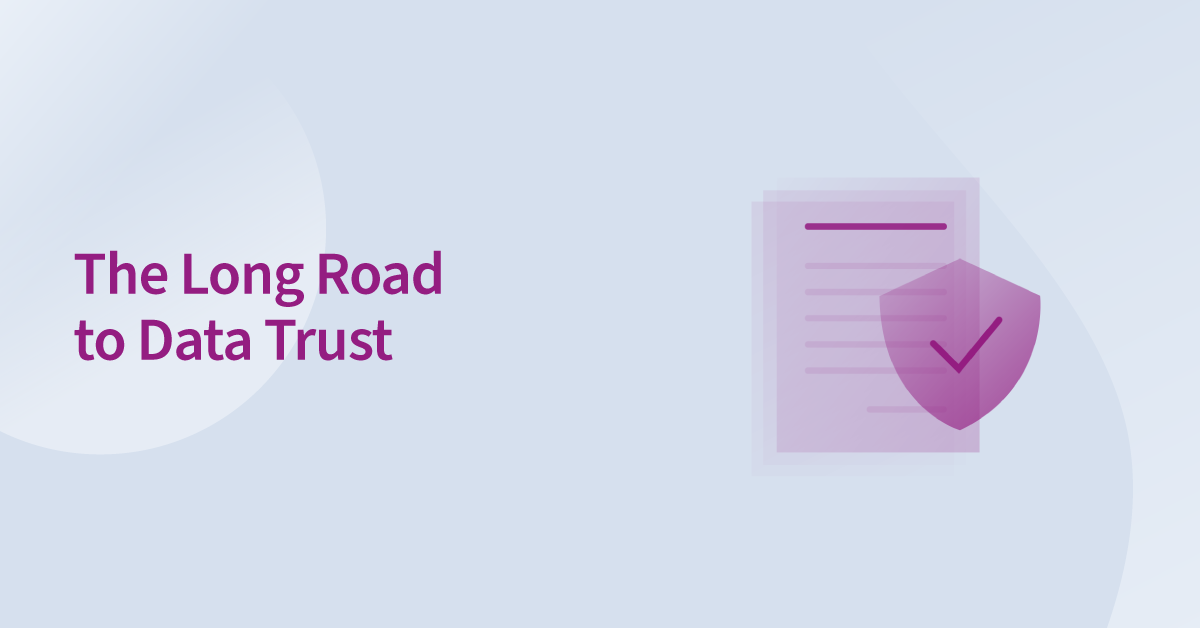The Long Road to Data Trust

Picture yourself driving your car. The speedometer, petrol gauge, and sat-nav all display data that tells you when you need to accelerate and brake, when to stop for petrol, and what route to take. The data you read informs your decision making.
A car dashboard highlights how we rely on data all the time in our everyday decision making. And we often do it without realising it, as the ease with which data is fed to us makes our decision-making process quick and easy. If the speedometer tells us we’re going too fast, we take immediate action and slow down.
Why we don’t make decisions in the same way when considering data at work? Why don’t we trust the data as we do with, say, our speedometer?
Understanding and trust
There are many reasons why there would be a disconnect between the data we’re being fed at work and our lack of action. One could be a lack of understanding of the data we’re shown as, let’s face it, most data outputs aren’t as simple or binary as a petrol gauge. The complexities of workplace data, where data streams are often fed into our dashboards (or spreadsheets!) from an array of disparate yet interconnected sources. The mechanical flow of data is not as simple as ‘push down on the pedal, go faster, see speed increase reflected in the speedometer.’ In addition, perhaps we struggle to trust the data we’re being fed in the workplace. Perhaps it is because of the disconnect that we have with the data in the sense of us not having had a prior relationship with said data, but perhaps it is something else.
When driving, we tend to implicitly trust the data on the dashboard as a result of a deep set of experiences that have never let us down. However, if our car started displaying incorrect data, we’d quickly end up with a speeding ticket, out of petrol, or lost. If this were to occur, we would quickly lose trust and take immediate action to understand the cause, making sure that the underlying problems were remediated as soon as possible.
Again, we need to ask, why don’t we hold data in business to such a high standard?
That is, of course, a crass generalisation but lack of trust in data can hold businesses back, preventing them from reinventing business models and truly becoming data driven organisations.
Failures of data
An infamous case of a business failing with data is one that involves one of the world’s most esteemed corporations, Apple.
When Apple released an early version of the iPhone, the data used by the Maps app was a disaster. The app automatically replaced Google Maps app as Apple decided that it no longer wanted to give Google all that valuable information. As a substitute, Apple bought mapping data from a range of suppliers, bringing it together to display on Apple’s homegrown software.
The outcome was laughable, with missing buildings, misleading routes and bizarre imagery. The Statue of Liberty? Gone. The Brooklyn Bridge? No more. Users were getting lost left, right and centre and Apple had a major crisis on their hands.
A serious lesson
These failures seem funny, especially when the victim of the joke is one of the world’s most fault-free companies, but the outcomes could have been dangerous. It was concerning for Apple because users immediately lost trust in its data and this failure resulted in a huge amount of reputational damage that Apple did well to build back from.
The problems for Apple stemmed from having a small, inaccurate data set. It was a case of “rubbish in, rubbish out.” And this teaches us that if we use poor quality data in our inputs, we only get bad outputs. Without good inputs, we will never trust in the outputs we’re viewing.
More than inputs
We must also think about trust when considering whether to use other data sources. In theory, a variety of sources means we can include as much data as possible to build better pictures of markets, products and customers. So, we are also talking about data quality and lineage.
Let’s get back in the car and think about the range of possibilities that we take for granted. For example, instead of driving to the shops we could drive to, say, Paris or take a few rounds on a race track. We are faced with an almost infinite range of possibilities, and whether we choose to take any of them is not dependent upon the trust we have in our vehicle’s dashboard.
It may be 300 miles to Paris, which is about 30x the distance to the shops, but we could take this trip. Again, we ask, why don’t we look at business possibilities in the same way? Do we not trust the data that we’re being fed by the data outputs we’ve set up for our business? How do we fix it so that, one day, we choose to ’drive to Paris’ for our business?
A long road
Getting to a level of trust in the data at work is part of a wider journey and it can’t be fixed with one or two simple steps. As mentioned, there are more facets to business data than a speedometer, and the journey towards trust in data is a long one.
But, as with all long and worthwhile journies, the hardest mile is the first one. So beginning on the road to data trust is all-important, as once the beginnings of that implicit trust are there, you will be able to do more with data and more in your business than you ever thought possible.